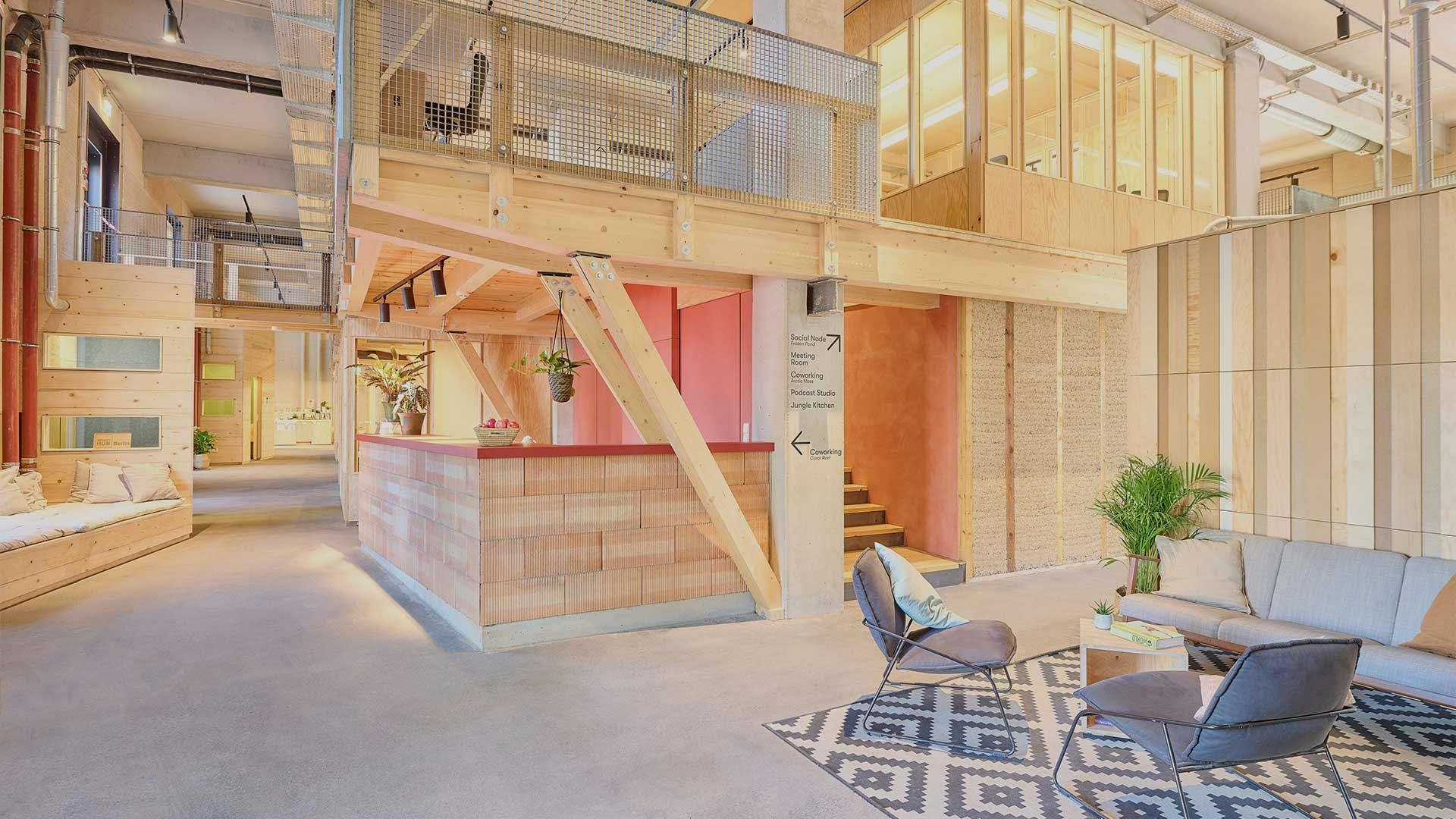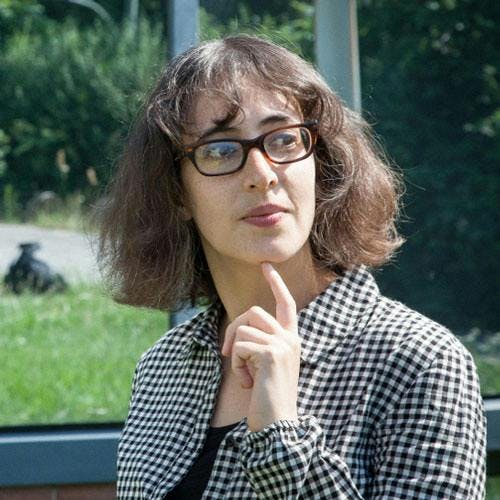Coworking with an impact: How Impact Hub Berlin built Europe’s largest sustainable coworking space
ustainability and the circular economy are buzzwords among startups, but when it comes to their workspaces, how many practice what they preach? With their new coworking space, the innovators of Impact Hub Berlin hope to prove that social and environmental change begins at home – or rather, in the office.
It’s hard to find the door to Impact Hub Berlin amid all the scaffolding. Hidden between a go-kart track and a scrappy-looking community garden, the 3,500 m2 building is still a construction site and will remain that way for some time as two additional stories are built on top of it.
Inside, though, the brand-new coworking space is already up and running. Sitting at long tables and on comfortable midcentury-modern style chairs, in rooms named after ecosystems (Arctic Moss, Coral Reef) or the unlikely keystone species that hold ecosystems together (Gorilla, Lemming), Impact Hub Berlin’s young members huddle over laptops or engage in animated conversation.
With its sparse industrial design and copious amounts of unfinished wood, the space could be any tech hive anywhere in the world… if not for a few very important differences. For example, the soundproof phone booths are made of wood that comes from coffins – no, not real ones, but replicas built for a Yoko Ono art installation in Leipzig. And the wire-mesh guardrails lining the upstairs gallery are discards from the Berlin public transit authority. The windows may look square, but in fact they’re “circular,” says Impact Hub Berlin cofounder Leon Reiner, in the sense that they’ve been recovered from other buildings and installed here.
From the walls made of carbon-friendly “hempcrete” to the still-in-progress restaurant that will someday serve zero-waste, vegetarian meals, just about every aspect of Impact Hub Berlin is designed with sustainability and the circular economy in mind. This design befits a project that aims to, among its many other ambitions, support and incubate the next generation of circular-economy pioneers.
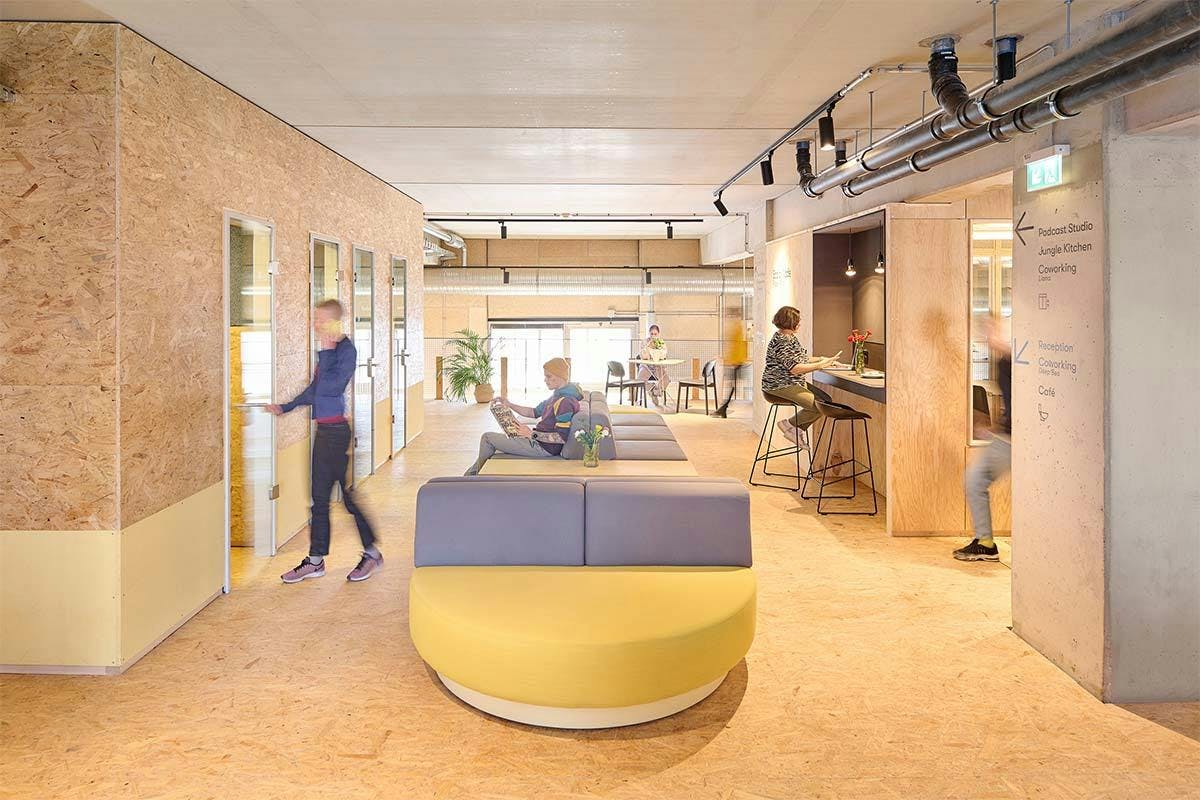
Impact Hub Berlin. Photo: ©Impact Hub Berlin
A circular history
The building that is home to Impact Hub Berlin, called the CRCLR House, all started with beer. In the late 1800s, brewers began constructing storage and fermentation cellars within the Rollberg, a hill in southern Berlin. This eventually turned into the Kindl complex, a sprawling collection of buildings that included a gigantic brewing house, a power station, multiple warehouses and a maze of cellars. It survived both World War II and the city’s division only for the Kindl corporation to abandon it in 2005. As the neighborhood around it, Neukölln, started attracting artists and international transplants, parts of the complex slowly began returning to life. Some of the old cellars became studios, and a go-kart track, a queer dance club and a craft brewery moved in.
But the major transformations didn’t happen until the middle of the 2010s, when the Swiss residents arrived: the brewhouse, a cathedral-like art deco building, was taken over by a millionaire couple from Zürich and turned into a new exhibition space, the Kindl Center for Contemporary Art (opened in 2016); and most of the rest of the complex was purchased by the Basel-based Edith Maryon Foundation, a nonprofit devoted to rescuing urban properties from money-hungry speculators and leasing them to projects with a social, cultural or ecological focus.
One of the buildings bought by the foundation was the former keg-filling hall, a two-story rectangular structure with a one-degree incline built into the floor so that barrels could easily be rolled down it. It was claimed by an ecologically-minded Berlin collective calling themselves TRNSFRM. By renovating and rebuilding the hall using “circular” materials, TRNSFRM aimed to demonstrate that sustainable and affordable construction was possible. All it needed was the right tenant.
From the beginning, we wanted to include the community
A tenant with impact
That’s where Leon and his team came in. Since 2013, they’d been operating the Berlin location of Impact Hub, a decentralized global network focused on supporting socially and environmentally friendly entrepreneurship. In their case, this meant running accelerator and incubator programs for sustainability-minded businesses, forging partnerships with the German government and corporations such as Samsung, and creating a space where their community could come together to cowork, collaborate and host events. However, their rooms in Kreuzberg were growing too small for them, and even as the pandemic put in-person gatherings on hold, it was clear that they would eventually need to scale up. Meanwhile, TRNSFRM was seeking a worthy occupant for its soon-to-be-completed CRLCR House.
In mid-2021, Impact Hub Berlin and the collective joined forces. Leon and his team took over the remaining renovations with the help of local architecture firm LXSY and with input from their members and neighbors. “From the beginning, we wanted to include the community,” says Leon. “We had a participatory design process, which the architects then translated into an actual design. We had to make compromises on things like the colors or the exact materials, but basically I think it worked quite well.”
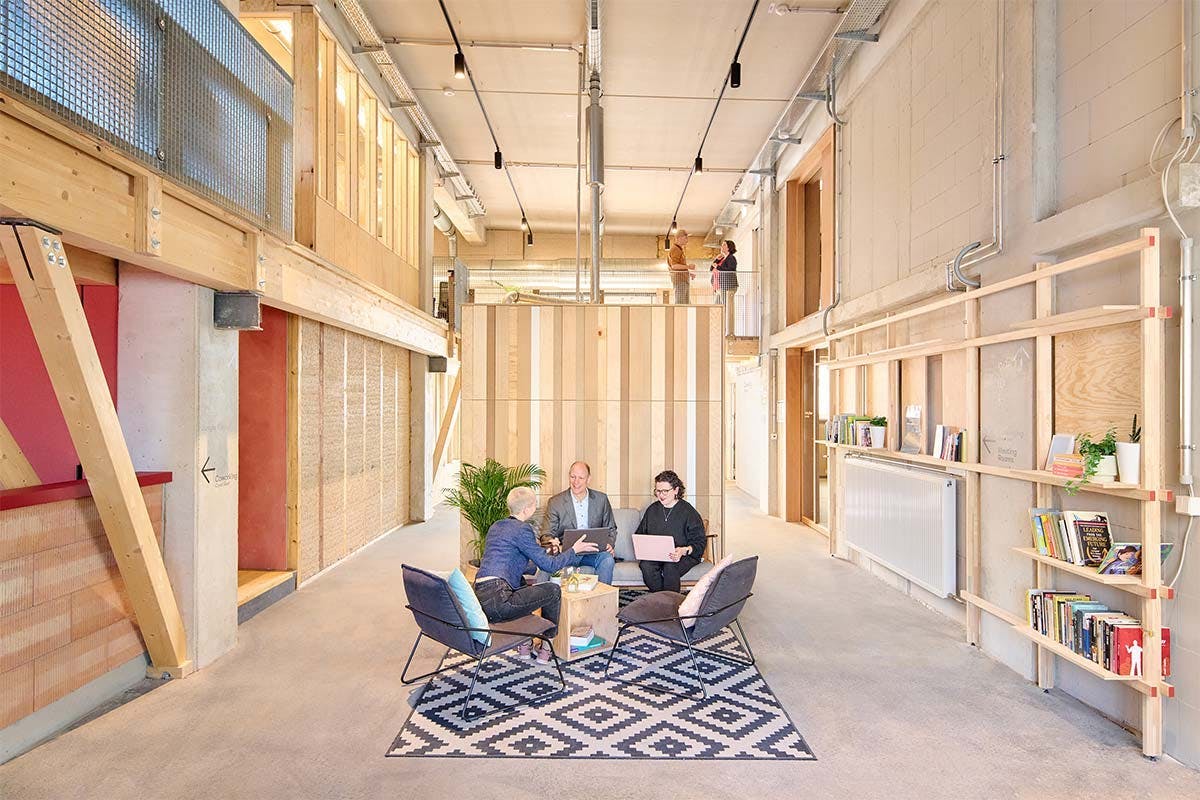
Impact Hub Berlin. Photo: ©Impact Hub Berlin
A constructive challenge
When it comes to constructing a building as sustainably as possible, compromise is key. With its heavy use of non-renewable resources and carbon-intensive materials like concrete, construction is traditionally one of the world’s most environmentally harmful industries; it’s reported to be responsible for 38 percent of global emissions and nearly one-third of all waste generated in the EU.
The TRNSFRM and Impact Hub Berlin teams couldn’t avoid using concrete or new materials entirely, especially in the face of Germany’s exacting building codes. “These doors, for instance, had to be new because they needed to be fire-resistant. We’d never have gotten the permissions otherwise.” Nor could they avoid contracting conventional construction firms (which aren’t exactly known for their fair pay or gender equity) for the heavy-duty work, such as the addition of the upper stories.
Still, they were committed to “finding out how far we could realistically go” before turning to less sustainable solutions. That meant scavenging as much as they could from demolished buildings and art installations, researching alternative materials such as hempcrete, and entrusting much of the interior work to a collective of “former artists, free builders, and a lot more women and people from other countries than what you’d normally see.”
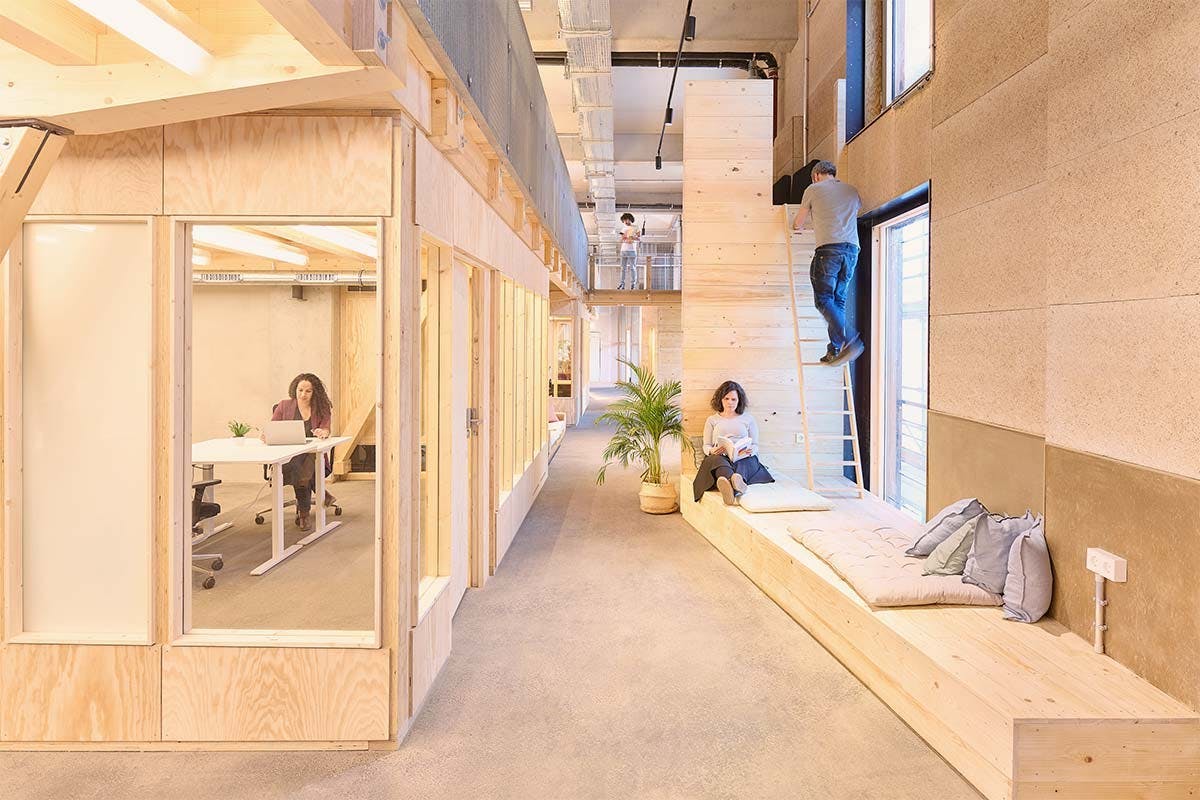
Impact Hub Berlin. Photo: ©Impact Hub Berlin
Life at the hub
Apart from construction, the Impact Hub Berlin crew is dedicated to finding sustainable ways to run their space, both now and in the years to come. The building uses renewable energy sources and is cleaned using ionized water rather than traditional harsh chemicals. Its furniture is upcycled or rented, and anything that breaks is sent for repairs rather than thrown away.
For now, Impact Hub Berlin consists of two and a half stories. At street level, six maker labs provide space and equipment for member startups to experiment. Above them is the main reception desk as well as coworking rooms, phone booths and offices that are rented out to teams for six months or longer. Eventually there will also be a café/restaurant with an outdoor terrace. Finally, there’s the upstairs gallery, with more offices and space for coworking as well as a kitchen and podcast studio.
All Impact Hub Berlin members must, in Leon’s words, “work or intend to work in the broad field of sustainability.” They are founders, event organizers, software engineers, journalists and more. Current residents include the sustainable fashion company Circular Sweater Project, the open-source electronics startup Open Funk, and the plastic recovery and recycling project Wildplastic. Once the upper floors are finished, up to one thousand people will be using the building regularly, whether as a daily “Resident” or a one-day-a-month “Connect” member.
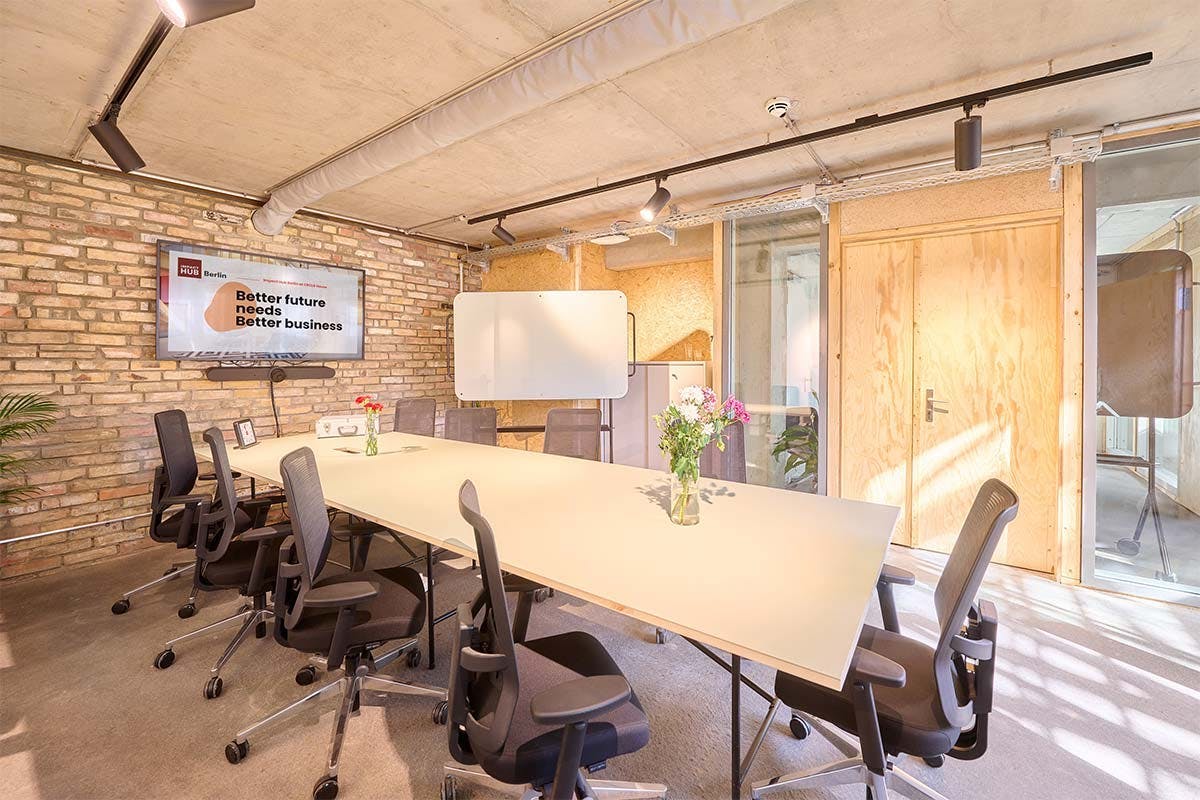
Impact Hub Berlin. Photo: ©Impact Hub Berlin
It takes a village
Leon and the Impact Hub Berlin team are aware of the, well, impact the tech crowd can have on a gentrifying neighborhood like Neukölln. Though the area around the former brewery was changing long before they came along, especially with the opening of the Kindl art center in 2016, it remains one of the city’s lowest income districts. An influx of techies, no matter how sustainability minded, could wreak havoc on residents’ already rising rents.
Then again, as Leon points out, “Change is inevitable in a city like Berlin. The question for me isn’t if things will change, but how.” He’s doing his best to make sure Impact Hub Berlin fits in with the rest of the projects supported by the Edith Maryon Foundation, which include Alltag, a building that provides temporary shelter to people in need; and Global Village, a collection of offices, meeting rooms and event spaces used by some fifty local NGOs.
The space’s coworking rates are lower than elsewhere in Berlin, topping out at €149 ($163) per month for a full-time membership, and the restaurant will offer affordable dishes once it’s opened. Becoming a functional part of the neighborhood “won’t happen from today to tomorrow,” Leon acknowledges, but it’s certainly a long-term goal. “Ultimately, it’ll be a test of time to see how well we can integrate with everyone who’s here.”
Change is inevitable in a city like Berlin. The question for me isn’t if things will change, but how.
Coming full circle
With the new building comes a new mission. Since the beginning of 2022, Impact Hub Berlin has decided to focus on four key areas, or “ecosystems”, beginning with the circular economy. Some of the startups already using the space are part of “Circular Together,” a new six-month incubator program that kicked off in March 2022.
The space itself is due to be finished by the end of the year, although, as Leon points out, nothing about CRCLR is set in stone. Nearly every part of the building’s interior can be easily disassembled and rebuilt according to the community’s needs, minimizing waste and the use of virgin materials in the future. “Figuring out how people are actually using the space, where we might need to change stuff, that’s going to be an ongoing process.”
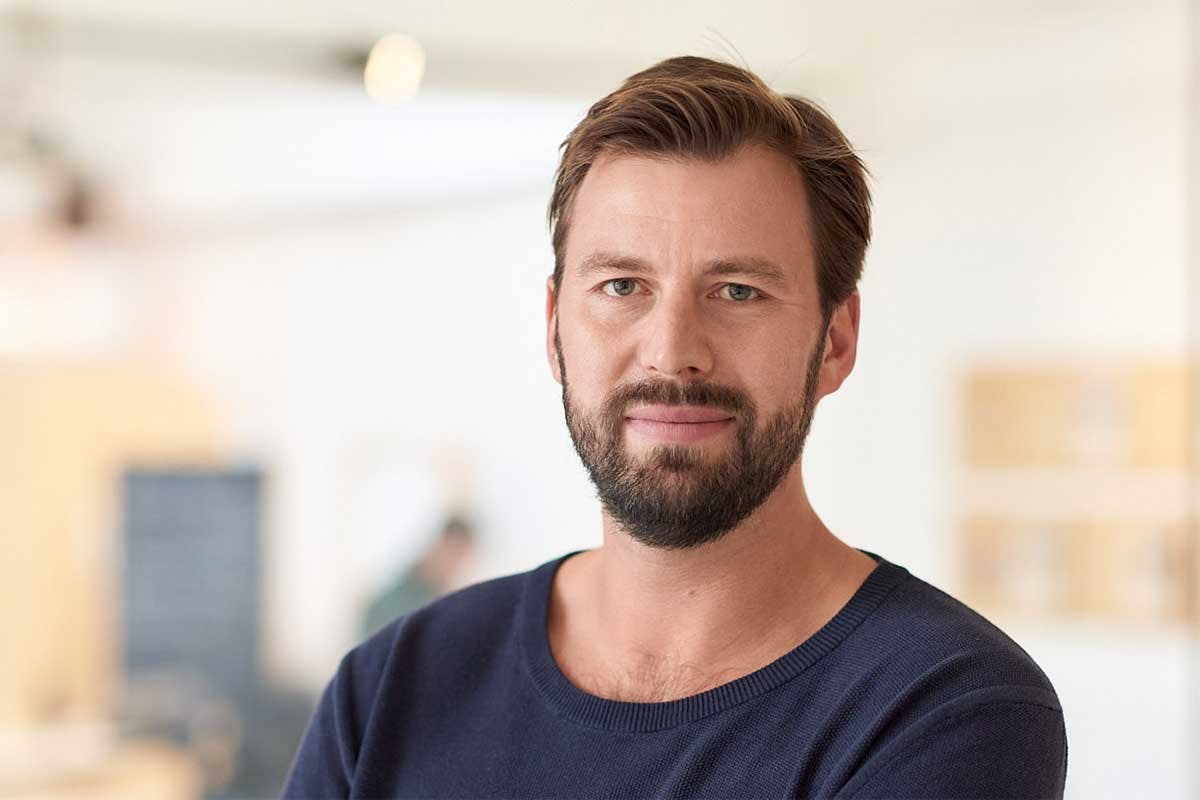
Leon Reiner, co-founder and managing director of Impact Hub Berlin. Photo: ©Impact Hub Berlin
By modeling an innovative, environmentally friendly way to build and run a coworking space, Leon Reiner and his team at Impact Hub Berlin are “walking the walk” when it comes to sustainability.
Photography by ©Impact Hub Berlin
